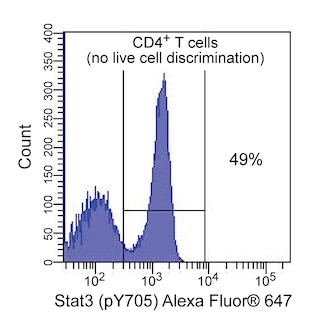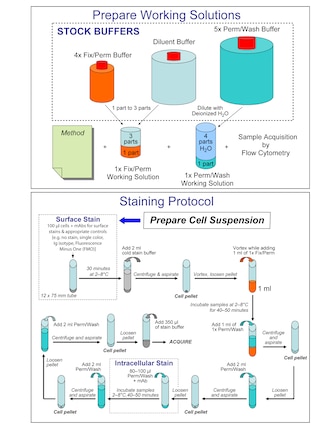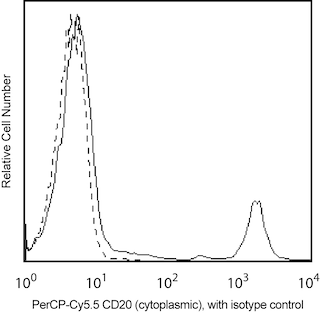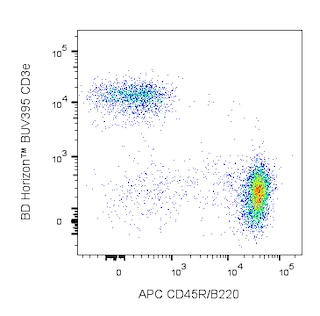-
Your selected country is
Middle East / Africa
- Change country/language
Old Browser
This page has been recently translated and is available in French now.
Looks like you're visiting us from {countryName}.
Would you like to stay on the current country site or be switched to your country?


.png)

Multicolor flow cytometric analyses of XBP-1S expressed in human and mouse cells. Panel 1. Analysis of XBP-1S expressed in activated human peripheral blood mononuclear cells (PBMC). Human PBMC were stimulated with 10 μg/ml ODN 2006 Type B CpG Oligonucleotide (Invivogen, Cat. No. tlrl-2006-1) at 37˚C for 7 days. The cells were harvested and incubated with BD Horizon™ Fixable Viability Stain 450 (Cat. No. 562247), fixed in 1X Fix/Perm Buffer (BD Pharmingen™ Transcription Buffer Set, Cat: 562574) at 2-8˚C (45 min) and permeabilized in 1X Perm/Wash Buffer (Transcription Buffer Set) at 2-8˚C (45 min). Cells were stained with PE Mouse anti-XBP-1S (Cat. No. 562642) and PerCP-Cy™5.5 Mouse Anti-Human CD20 (Cat. No. 558021) antibodies. Two-color flow cytometric contour plots showing the correlated expression of CD20 versus XBP-1S (or Ig isotype control staining) were derived from live-gated events with the forward and side light-scatter characteristics of intact lymphocytes. Flow cytometry was performed using a BD FACSCanto™ II Flow Cytometer System. Panel 2. Analysis of XBP-1S expressed in activated mouse splenocytes. BALB/C splenocytes were stimulated with 1 μg/ml lipopolysaccharide (LPS; Sigma Cat. No. L3137) at 37˚C (3 days). Cells were incubated with Fixable Viability Stain 450, fixed in 1X Fix/Perm Buffer, and permeabilized in 1X Perm/Wash Buffer as described for Panel 1. The cells were stained with PE Mouse anti-XBP-1S and APC Rat Anti-Mouse CD45R/B220 (BD Cat. No. 553092). The cells were then analyzed as described above. Contour plots showing the correlated expression of B220 versus XBP-1S (or Ig isotype control staining) were derived from live-gated events with the forward and side light-scatter characteristics of intact lymphocytes.
.png)

BD Pharmingen™ PE Mouse anti-XBP-1S
.png)
Regulatory Status Legend
Any use of products other than the permitted use without the express written authorization of Becton, Dickinson and Company is strictly prohibited.
Preparation And Storage
Recommended Assay Procedures
Note: For optimal immunofluorescent staining of XBP1-S, the Transcription Factor Buffer Set (Cat. No. 562574) is highly recommended for the brightest staining results.
Product Notices
- This reagent has been pre-diluted for use at the recommended Volume per Test. We typically use 1 × 10^6 cells in a 100-µl experimental sample (a test).
- For fluorochrome spectra and suitable instrument settings, please refer to our Multicolor Flow Cytometry web page at www.bdbiosciences.com/colors.
- Please refer to www.bdbiosciences.com/us/s/resources for technical protocols.
- Caution: Sodium azide yields highly toxic hydrazoic acid under acidic conditions. Dilute azide compounds in running water before discarding to avoid accumulation of potentially explosive deposits in plumbing.
- Source of all serum proteins is from USDA inspected abattoirs located in the United States.
Companion Products






The Q3-695 monoclonal antibody specifically binds to XBP-1S, the spliced isoform of X-box binding protein 1 (XBP-1). XBP-1S is generated by cells that undergo an unfolded protein response, ie, cells responding to the accumulation of unfolded proteins in the endoplasmic reticulum. It plays important roles as a transcription factor in a number of important cellular processes including the regulation of MHC class II genes, differentiation of plasma cells, immunoglobulin secretion and hepatocyte growth.

Development References (3)
-
Gass JN, Gifford NM, Brewer JW. Activation of an unfolded protein response during differentiation of antibody-secreting B cells. J Biol Chem. 2002; 277(50):49047-49054. (Biology). View Reference
-
Iwakoshi NN, Lee AH, Vallabhajosyula P, Otipoby KL, Rajewsky K, Glimcher LH. Plasma cell differentiation and the unfolded protein response intersect at the transcription factor XBP-1. Nat Immunol. 2003; 4(4):321-329. (Biology). View Reference
-
Yoshida H, Matsui T, Yamamoto A, Okada T, Mori K. XBP1 mRNA is induced by ATF6 and spliced by IRE1 in response to ER stress to produce a highly active transcription factor. Cell. 2001; 107(7):881-891. (Biology). View Reference
Please refer to Support Documents for Quality Certificates
Global - Refer to manufacturer's instructions for use and related User Manuals and Technical data sheets before using this products as described
Comparisons, where applicable, are made against older BD Technology, manual methods or are general performance claims. Comparisons are not made against non-BD technologies, unless otherwise noted.
For Research Use Only. Not for use in diagnostic or therapeutic procedures.
Report a Site Issue
This form is intended to help us improve our website experience. For other support, please visit our Contact Us page.